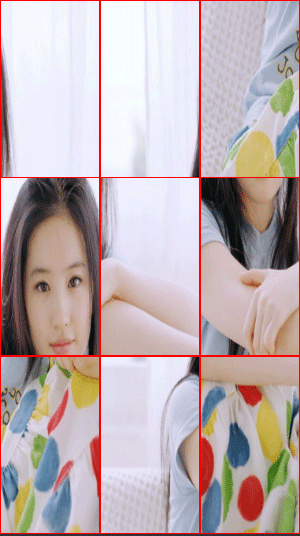
Sliding puzzle means dividing a picture into equal parts, shuffling the order (picture below), and then sliding them together to form a complete picture.

To implement a jigsaw puzzle, you need to consider how to randomly shuffle the order, how to swap the positions of two pictures, etc. However, after using Flexbox layout, you don’t need to think about this. The browser will do it for you. Flexbox is so powerful. For an introduction to Flexbox, click here.
What is used in this game is the order attribute of Flexbox layout. The order attribute can be used to control the order of Flex items.
Here I use nine canvas elements to divide the image into nine equal parts. You can also use other methods, such as background image positioning:
<div class="wrap"> <canvas></canvas> <canvas></canvas> <canvas></canvas> <canvas></canvas> <canvas></canvas> <canvas></canvas> <canvas></canvas> <canvas></canvas> <canvas></canvas> </div>
If it is not limited to nine-square grid, but also sixteen-square grid, etc., the above elements can be generated dynamically.
The following is the code to generate nine pictures in shuffled order:
var drawImage = function (url) {
return new Promise(function (resolve, reject) {
var img = new Image();
img.onload = function () {
resolve(img);
};
img.src = url;
})
};
drawImage("2.jpg").then(function (img) {
var arr = [1, 2, 3, 4, 5, 6, 7, 8, 9];
var random = arr.sort(function() {return Math.random() > 0.5});
[].forEach.call(document.querySelectorAll("canvas"), function (item, i) {
item.width = $(".wrap").clientWidth / 3;
item.height = $(".wrap").clientHeight / 3;
item.style.order = random[i];
var ctx = item.getContext("2d");
ctx.drawImage(img, img.width * (i % 3) / 3, img.height * Math.floor(i / 3) / 3, img.width / 3, img.height / 3, 0, 0, item.width, item.height);
});
});
The key code above is:
item.style.order = random[i];
By shuffling the order of the numbers and randomly assigning them to the order attribute of each canvas element, the browser will automatically sort them for you.
I won’t go into other details about the code. Here’s how to swap the positions of two pictures. It’s surprisingly simple:
var order1 = item.style.order; var order2 = target.style.order;
You only need to exchange the order attribute values of both parties.
Full code
<!DOCTYPE html>
<html>
<head lang="en">
<meta charset="UTF-8">
<meta content="width=device-width, initial-scale=1.0, maximum-scale=1.0, user-scalable=0" name="viewport" />
<meta content="yes" name="apple-mobile-web-app-capable" />
<meta content="black" name="apple-mobile-web-app-status-bar-style" />
<meta content="telephone=no" name="format-detection" />
<title></title>
<style>
html, body {
height: 100%;
}
body {
margin: 0;
padding: 0;
overflow: hidden;
}
.wrap {
display: flex;
flex-wrap: wrap;
width: 100%;
height: 100%;
overflow: hidden;
}
.wrap canvas {
width: 33.3333%;
height: 33.3333%;
border: 1px solid red;
box-sizing: border-box;
}
</style>
</head>
<body>
<div class="wrap">
<canvas data-value="1"></canvas>
<canvas data-value="2"></canvas>
<canvas data-value="3"></canvas>
<canvas data-value="4"></canvas>
<canvas data-value="5"></canvas>
<canvas data-value="6"></canvas>
<canvas data-value="7"></canvas>
<canvas data-value="8"></canvas>
<canvas data-value="9"></canvas>
</div>
<script>
var $ = function (el) {
return document.querySelector(el);
};
var touchMove, touchEnd;
var drawImage = function (url) {
return new Promise(function (resolve, reject) {
var img = new Image();
img.onload = function () {
resolve(img);
};
img.src = url;
})
};
drawImage("2.jpg").then(function (img) {
var arr = [1, 2, 3, 4, 5, 6, 7, 8, 9];
var random = arr.sort(function() {return Math.random() > 0.5});
[].forEach.call(document.querySelectorAll("canvas"), function (item, i) {
item.width = $(".wrap").clientWidth / 3;
item.height = $(".wrap").clientHeight / 3;
item.style.order = random[i];
var ctx = item.getContext("2d");
ctx.drawImage(img, img.width * (i % 3) / 3, img.height * Math.floor(i / 3) / 3, img.width / 3, img.height / 3, 0, 0, item.width, item.height);
});
});
document.addEventListener("touchstart", function (e) {
var target = e.target;
if (e.target.tagName.toLowerCase() !== "canvas") {
return;
}
var ctx = target.getContext("2d");
var image = ctx.getImageData(0, 0, target.width, target.height);
var obj = target.cloneNode(true);
obj.getContext("2d").putImageData(image, 0, 0);
var top = target.getBoundingClientRect().top, left = target.getBoundingClientRect().left;
obj.style.cssText = "position: absolute; top: " + top + "px; left: " + left + "px";
document.body.appendChild(obj);
var point = {"x": e.touches[0].pageX, "y": e.touches[0].pageY};
document.addEventListener("touchmove", touchMove = function (e) {
obj.style.cssText = "position: absolute; top:" + (e.touches[0].pageY - point.y + top) + "px; left: " + (e.touches[0].pageX - point.x + left) + "px";
});
document.addEventListener("touchend", touchEnd = function (e) {
var pos = {"x": e.changedTouches[0].pageX, "y": e.changedTouches[0].pageY};
[].forEach.call(document.querySelectorAll(".wrap canvas"), function (item, i) {
var offset = item.getBoundingClientRect();
if (pos.x > offset.left && pos.x < (offset.left + item.width) && pos.y > offset.top && pos.y < (offset.top + item.height)) {
var order1 = item.style.order;
var order2 = target.style.order;
if (obj.parentNode) {
document.body.removeChild(obj);
}
item.style.order = order2;
target.style.order = order1;
}
});
document.removeEventListener("touchmove", touchMove);
document.removeEventListener("touchend", touchEnd);
})
})
</script>
</body>
</html>When you are testing, it is best to use Google emulator or mobile phone to open it, because only mobile touch events are supported.
Only the basic functions are implemented in the code, and the complete functions are not implemented.
 How to make charts and data analysis charts in PPT
How to make charts and data analysis charts in PPT
 Android voice playback function implementation method
Android voice playback function implementation method
 AC contactor use
AC contactor use
 The difference between vscode and visual studio
The difference between vscode and visual studio
 The difference between Java and Java
The difference between Java and Java
 Introduction to hard disk interface types
Introduction to hard disk interface types
 nagios configuration method
nagios configuration method
 How to delete a folder in linux
How to delete a folder in linux




